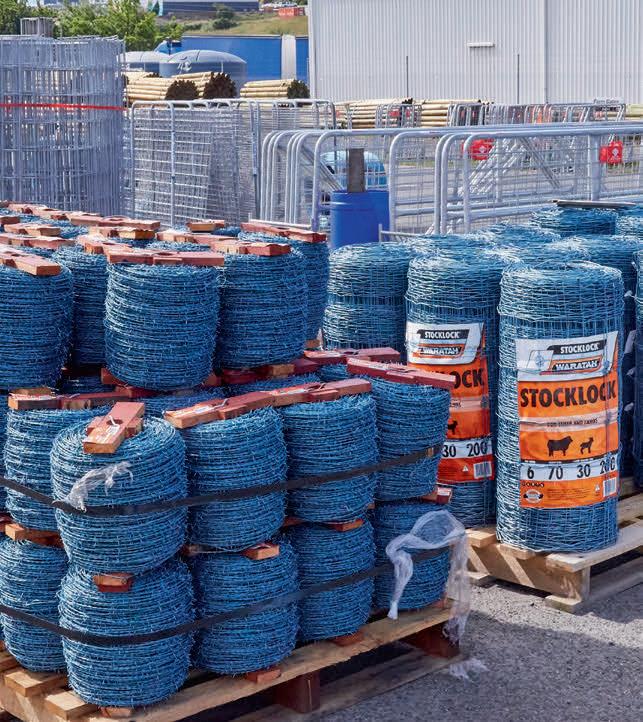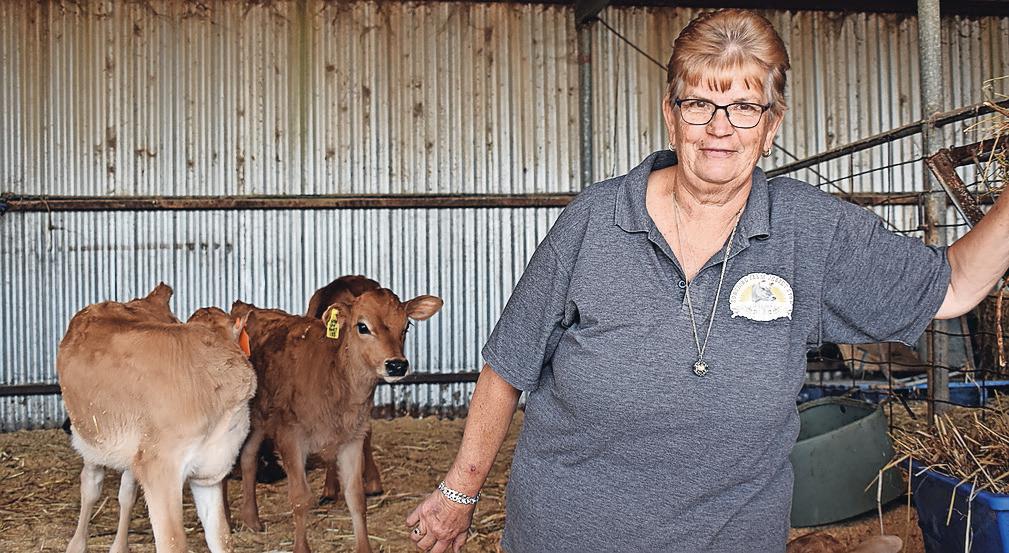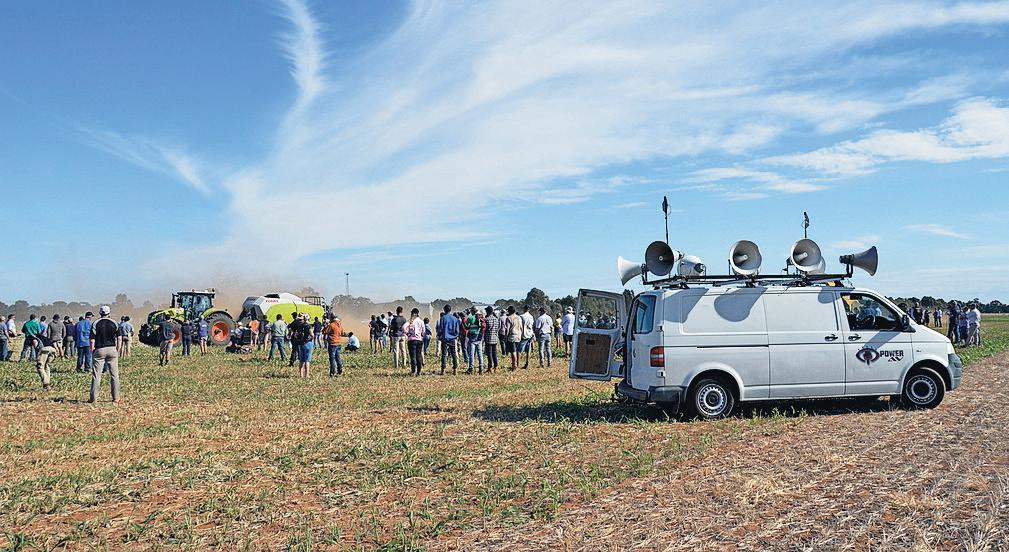AG Warehouse™ aims to support our customers in the areas of cropping, dairy, livestock, equine and lifestyle farming with the latest technologies and best products available in the market through our strategic vendor partners. Our team is experienced, knowledgeable and focused on servicing the farming needs of our customers.














AUGUST, 2023 ISSUE 154
DAIRY DREAM COMES TRUE
Dairy
2023
of
in Dairying
5.
ALL THINGS RURAL ...That’s what we do better!
Fuel available at these stores. VICTORIA & NSW STORE LOCATIONS - TRADING HOURS MON-FRI 8AM-5PM SAT 9AM -12PM. Times may vary - contact store. îs. 32519 Korumburra Leongatha Maffra Numurkah
FARM SUPPLIES PASTURE & CROP ANIMAL MANAGEMENT GENERAL MERCHANDISE
A dream to attend World
Expo will become a reality for young Cohuna dairy farmer Emmalea Wishart after she won the
Power
Women
Scholarship. Story, Page
MURRAY REGION
Bega Cobram Cohuna Colac Corryong Dumbalk Eskdale Finley Foster Heywood Kiewa Koroit
Orbost Rochester Simpson Swan Hill Wangaratta Warragul Wonthaggi Yarram
VISIT OUR WEBSITE agwarehouse.com.au
Con dent start to season Chair’s message







THE PAST couple of months has seen the release of continued strong milk prices giving continued confidence to the industry going into a new season.
With it we have also endured wetter conditions throughout the winter months adding challenges in managing cell counts, grazing areas, crops and animal health — the flip side being there remains full catchments and plenty of water for the upcoming irrigation season.

In this edition of Dairy News we highlight information to support your business




COPING WITH WET PADDOCKS
Grazing of waterlogged paddocks can result in serious ‘pugging’ damage to pastures and soils.
This damage can reduce pasture utilisation by up to 50 per cent, and reduce pasture yields by 20 to 80 per cent over the following four to eight months.

Further, these conditions can increase the likelihood of animal health problems such as lameness, mastitis and magnesium deficiencies.
Here are some low-cost practical management strategies that will reduce the impact of pugging.
‘On-o ’ grazing
This is the most practical and effective grazing strategy for most farms during prolonged wet conditions.
Cows are grazed on an area of pasture for a limited time, usually two to four hours, and then moved to a stand-off area such as a ‘sacrifice paddock’ or other hard standing area for the rest of the day.
To be successful, enough tall and dense pasture (2500 to 3000kg DM/ha) needs to be allocated to the herd to enable high and rapid pasture intakes.
Cows will usually consume 70 per cent
operations regarding managing wet soils and our newly revamped Cups On Cups Off course, renamed Milking Mastitis Management –CoCo 2.0.
Murray Dairy have formulated their annual operating plan for the year which provides an outline of key investments in research, development and extension offerings for dairy businesses in the region.

This includes national Dairy Australia programs such as Our Farm Our Plan, Workforce Attraction, Employment Basics, Nutrition Fundamentals, Advanced Nutrition
of their daytime pasture intake in the first two hours of grazing and 77 to 88 per cent after four hours.
Pugging damage is usually comparatively minor after four hours, with the bulk of the damage occurring four to 10 hours after the start of grazing.
Other grazing techniques
There are a range of other grazing strategies which used in combination can reduce the risk of pugging damage.
These include:

Scheduling the day and night feeds separately by allocating about two
and Milking Mastitis Management – CoCo 2.0, just to name a few, as well as an exciting three-year cropping research investment in partnership with Gardiner Foundation and Queensland Department of Agriculture and Fisheries.
If you would like to know more about what is on offer from Dairy Australia and Murray Dairy please contact the Murray Dairy team on 4811 6008, email admin@murraydairy.com. au or visit: www.murraydairy.com.au

 Andrew Tyler Murray Dairy chair
Andrew Tyler Murray Dairy chair
thirds of the 24 hour allocation of pasture for the day and a third for the night. Cows rest more and walk less at night.
Grazing the paddocks from the back first using a temporary sacrifice laneway constructed using electric fencing to stop cows walking over the front of the paddock.
Back fencing o previously grazed areas wherever possible. The more times a wet soil is walked over the greater the damage to pasture and soil structure.
Continued on page 3
2 // MURRAY REGION DAIRY NEWS AUSTRALIA AUGUST 2023 w w w . a e h g r o u p . n e t . a u
Manage mastitis in lactation
DESPITE OUR very best intentions to limit the number of cows with clinical mastitis and limit the spread of mastitis in our herds, an inevitable fact is we will never eliminate mastitis completely.
The past few months have certainly been challenging with all the wet, muddy and cold weather testing even the best mastitis plans.
Managing milk quality begins with understanding the risk factors on your farm and knowing what tools you have at your disposal to mitigate those risks.
A great place to start is Dairy Australia’s Milking Mastitis Management program.
This is the revamped working of the Cups On Cups Off workshop that has been running for a number of years. This course covers several key areas.
Understanding mastitis infection
Some bacteria in the cow’s environment can invade the teat and cause inflammation of the udder (aka mastitis). The number of white blood cells in the milk increase as the cow fights the mastitis infection.
When stripping the quarter if there are clots and a cheesy appearance for more than three squirts, the infection is called ‘clinical mastitis’.
Signs of clinical mastitis may range from mild with flecks and/or discolouration of milk; moderate with swollen quarters; to severe cases where the infection spreads from the udder to the cow causing signs of sickness (reduced appetite, rumen tucked, eyes sunken, head/ears drooping or cow sitting down not grazing in paddock).
When the infection only causes an increase in the cell count but no change in the appearance of the milk, the infection is known as ‘subclinical mastitis’.
Both types of infection will cause an increase in Somatic Cell Count (SCC) and decrease the volume of milk a cow produces. The SCC of an infected quarter can be 250,000 to many million cells per ml.
Treatment of mastitis
The cost to treat a case of mastitis is estimated at $400 per cow in 2023. The key to any treatment program is understanding if you have an issue.
Dairy Australia’s triggers for action for mastitis control are:
If you have more than five per cent of cows affected by clinical mastitis in the first 14 days after calving.
More than two per cent of cows affected by clinical mastitis in each month of lactation.


Appropriate antibiotic and anti-inflammatory treatment are most likely to be of benefit in cows with a newly acquired mastitis infection during lactation.
If the cow has a previous history of mastitis infection or the infection remains untreated for a while, then the chance of clearing the infection with lactating cow antibiotics is reduced.
Hence the merit of treating the cow must be considered against the type and level of infection, time taken to identify the issue and using her health, production and fertility records.
A written treatment protocol ensures consistency in treatment and reduces the risk of antibiotic residues reaching the vat.
Eighty per cent of residues occur as a result of not separating treated cows from the herd and off-label use of medication.
Things that should be written down in mastitis treatment protocol include:
When a cow needs treatment.
What treatments to be given and how to be given.
How to administer.
How to mark the cow and separate from main milking herd.
How and what to record.
When a cow should be culled.
Collecting a useful milk sample
A sample needs to be collected from the affected quarter before the cow receives antibiotic treatment.
Wearing clean disposable gloves and thoroughly cleaning the teat end with 70 per cent methylated spirits before collecting a milk sample will reduce the chance of contaminating the milk sample with dirt or dung. Contaminated milk samples may obscure identification of the bacteria causing the mastitis infection.
COPING WITH WET PADDOCKS

Continued from page 2
Considering shifting the fence on the allocated grazing area two to three times during the day.
Using di erent gateways to put cows on and o the paddock if possible.
Allocating the pasture to be grazed in square or rectangular blocks rather than long, narrow strips.
Slowing the grazing rotation to match pasture growth rates. Aim to have cows going into plenty of pasture (at least 2500 to 3000kg DM/ha) and leave post grazing heights of 4cm to 6 cm between clumps.
Avoiding the temptation to speed up the planned rotation length. Stick to the plan.
Grazing paddocks that are likely to have a wet soil problem early in the season.
Sacrifice paddocks and stand-o areas
Some form of stand-off area is required for ‘on-off’ grazing when cows are taken off the paddock. A ‘sacrifice paddock’ is the simplest and a low cost option suitable for most farms.
Ideally this should be a paddock with better drained soils on higher parts of the landscape, with run-down pasture requiring renovation and away from waterways.
Other areas that can be used to stand cows off on include:
Laneways: should only be regarded as a short term option as significant damage to the track surface can occur.
Feedpads and the dairy yard — cows should have room to lie down requiring at least 3.5 square metres/cow, or 5 square metres/cow if cows are on
After cleaning the teat end, the first few squirts of foremilk should be discarded and then a 5ml sample of milk should be collected into a sterile container. To reduce the risk of contaminating the milk sample during collection, the teat end must not touch the sample container, and nothing should touch the inside surface of the container lid.
The cow’s number, quarter sampled and date of sampling are useful to record on the sample container before delivery to the testing site (many veterinary clinics offer rapid mastitis testing service).
Even when the likely cause of infection has been established and an effective treatment protocol is put in place it is prudent to collect a milk sample before treatment in case of treatment failure.
Some bugs can protect themselves from antibiotic treatment by producing a special slime coating over their surface or may even have genes for antibiotic resistance.
If your initial treatment is unsuccessful, contact your veterinarian for further advice. The stored milk sample can be used up to six months from collection date.
Prevention of new infections
Understanding the types of infection is the first step in preventing infection.
If the cause of the mastitis in your cows is infection by bugs living in the environment (environmental mastitis), the focus of prevention must be to either decrease the exposure of your cow’s teats to dung and dirt or increase the protection in your cow’s teats.
Clean calving paddocks and avoiding calving cows on feedpads will reduce teat-end contamination.
If you are getting several cows coming in with mastitis on day one of milking, the use of teat-sealant products should be considered.
Teat-seal forms a physical barrier to udder invasion from environmental bugs.
Some bugs are difficult to culture as they hide inside cells in the udder and are not shed in the milk all the time, but the bugs can cause great damage to the udder tissue (cow associated mastitis).
Such bugs are found on the skin of the udder and their presence inside the udder suggests that there is a problem with cow hygiene or milking plant function allowing skin bugs to invade the udder. This may occur with uneven cup removal, high vacuum or short milk liners damaging teat ends.
Unless the cause of teat-end damage is stopped you will continue to have new mastitis infections occurring in your cows.
Milking practices begins with understanding how to implement effective, efficient stockmanship and care in milking processes on farm.
These include careful movement of stock to and from the paddock, thorough application of teat spray (two litres per 100 cows, per milking applied over the whole teat after milking), gentle even cup removal, avoiding over-milking and regular timely changing of rubber-ware.
These will all assist in reducing the incidence of new mastitis infections.
Good-conditioned cows with supple teats that have clean teat ends are more resistant to mastitis infection than cows in poor condition with low immunity, cracked teats and damaged teat-ends.
Having a good consistent milking routine, healthy cows and clean calving environment will minimise the incidence of new mastitis infections in your herd.
MMM program can help
The Dairy Australia Milking Mastitis Management program will help your farm team understand how to achieve good milking practices.
The MMM program is valuable for induction of farm staff entering the dairy industry as foundation for good milking practices while more experienced employees and farm mangers/owners will often gain practical useful information to improve operations, attention to detail and in turn milk quality.
For more information about the MMM program, contact Ross Read on 0438 906 613 or rread@murraydairy.com.au
– Ross Read, Murray Dairy regional extension officer animal performance
them for more than two days.
Purpose-built containment areas or loafing pads.
Supplementary feeding strategies
Supplements should be used in wet conditions as a tool to help maintain a slow grazing rotation and ensure cows are fully fed, especially during prolonged wet periods.
Well-fed cows cause less pugging damage as they are more content and do less walking around the paddock.
Where possible, feed supplements in the dairy, on the feedpad or other stand-off areas.
If feeding in the paddock, put out the feed before the cows enter the paddock and if small amounts are being fed, feed it under an electric wire.
Animal health
Prolonged wet and muddy conditions place the herd under additional stress. Increased stocking rates in sacrifice paddocks can increase the risk of mastitis, lameness and magnesium deficiency. Keep a close eye on all stock and treat any conditions as soon as possible.
For more information, visit feed. dairyaustralia.com.au
The key to any mastitis treatment program is understanding if you have an issue.
Having a good consistent milking routine will minimise the incidence of new mastitis infections in your herd.
MURRAY REGION // 3 DAIRY NEWS AUSTRALIA AUGUST 2023
Dairy Australia has tips for managing a wet winter.
From desk job to dairy farm
BY ANDY WILSON
‘EIERSCHALE ABSCHRECKEN’ is not commonly heard in the dairy industry, nor anywhere in these parts for that matter.
The reason is not only that it is a SwissGerman expression, but it also pertains to eggs, and in the burgeoning adventure of one former backpacker, the term’s double meaning is a paradox.
Sophia Bulling of Tatura could be forgiven for experiencing the ‘shock of a freshly boiled egg plunged into cold water’, which refers to someone when they experience a massive change, such as leaving her native Stuttgart for a new life.
Abschrecken also means ‘deterrence’, of which Sophia has experienced none in settling into the Goulburn Valley.
“I think it is hard to describe the change because it is so different; a shock but in a good way,” Sophia said.
Servicing car companies IT systems from a desk in Germany is worlds away from standing in a Goulburn Valley chill, escorting 800 dairy cattle across a road.
This is where Sophia has found herself after coming to Australia on a trip that was intended to be brief but ended up with the typical ‘double love’ that afflicts many backpackers.
“I just came for a working holiday and yes, exactly, I fell in love with the country and in love with an Australian of course,” she says with nary a blush but a broad grin.
The half-kilometre column of Friesians, dotted with the occasional Jersey, moves quietly from one side of the road to the other with precision, seeming to appear over one horizon and disappear over the other as the cows come in for their afternoon milking.


WiSA - Proudly Australian owned & manufactured for 28 years
Sophia manages this gently walking herd on her own from a short distance, armed only with a two-tone whistle, occasionally dashing off to stop the column and lower a rope across the road to let local vehicles through.
Between whistles and traffic control, she describes the sudden tree change in her life.
“It’s crazy because when I was working in that office back home, I always thought that office work was what I was headed to,” she said.
“But then I started working here and I thought ‘what have I done in the last couple of years’?’
FARM & IRRIGATION AUTOMATION EXPERTS
Smarter irrigation for your farm
• WiSA’s automated irrigation system can deliver water when required and on time
• WiSA’s wireless solution means you have total control from your mobile phone or computer
• WiSA improves water use efficiency and can reduce labour costs

• WiSA’s automated irrigation system can improve the sustainability of your dairy farm, vineyard, orchards, and fields
Contact us:
Phone: 1300 887 380
Email: sales@irrigatewisa.com.au
Web: www.irrigatewisa.com.au
“I took the longer way but found my place.
“I just love it; and yes, it’s a physical job and sometimes you have days when you’re a bit down or get angry with the cows, but every day is different.”
She suddenly dashes off to whistle along a Jersey that has stopped in the road to pose for my camera, aware that she is different from the crowd.
Sophia returns without skipping a beat.
“And you have lots of opportunities because I mainly started with milking, and I said to the boys that I would be really interested in learning other things.
“They basically started showing me things and — ”
She leaves again to lower the rope, returning after some cheerful waves with drivers crawling past in their cars.
“I mean they are my bosses, but I feel like we all have that friendship a bit and it makes it so much easier.”
Her bosses are brothers Markus and Phil Lang, who run the family dairy farm now into its second generation.

“If you have a problem, they are understanding and when I ask for learning more about things, they like to show me.”
Apart from an uncle with a few nonproduction sheep, Sophia said her family had no farming background.
She said the contrast between her office job and the dairy was something that could not be expressed effectively between two languages. The laissez-faire approach of Australian life is also different from the organisational rigours of her homeland.
“Over there, it’s really straight that way, and everyone has to follow the rules.
“But it’s not Germany here!
“I used to stress about being five minutes late for a meeting because in Germany, if you have a meeting at nine, then you turn up 10 minutes before nine and it starts at nine.
“Here? You can just turn up on the right day.” Her humour is clearly making the transition just as well.
And in a blink, she’s gone again to push along another Jersey media tart who’s holding up the others, then lower the rope once more before disappearing with the herd as the column nears its end.
Sophia waves from a distance and heads down to the milking shed, her day just beginning in the middle of an afternoon.
Sophia Bulling experienced the common ‘double love’ when she visited for a working holiday, falling not only for a local, but for her new career in the dairy industry. Photos: Andy Wilson
4 // MURRAY REGION DAIRY NEWS AUSTRALIA AUGUST 2023 88612
The 800-strong herd makes its well-organised and quiet way to the milking shed in a slow-moving half-kilometre column at Lang Dairies at Tatura.
Dairy expo dream comes true
BY SOPHIE BALDWIN
A DREAM to attend World Dairy Expo is set to become a reality for young dairy farmer Emmalea Wishart after she won the Power of Women in Dairying Scholarship for 2023.

Attending the expo has always been on Emmalea’s bucket list and now with the aid of the scholarship, her dream will come true when she heads over to the United States in September.
“I am still in the planning process but I am just so grateful to have received this scholarship and I am really looking forward to all the opportunities it will bring,” the 24-year-old said.
Along with a few tourist trips, Emmalea is hoping to visit some farms and pick up a bit of additional knowledge on calf rearing — a job she has recently taken total responsibility for on the family farm at Cohuna.
Farming with her parents Tina and Rick and sister April (other sister Kaitlyn is at Maffra) the family business milks 370 split calving cows on 520ha.
“Mum always did the calf rearing but I took over after she hurt her back a couple of years ago. I am a bit more knowledgeable and confident in my ability now, but I am always looking to do things better and I hope I can pick up some new tips and tricks while I am overseas.’’
Emmalea has spent her life among cows and tractors, although her parents did make her head off to university and have a shot at life away from the farm.
“I studied a bachelor of exercise science for three years and then went off to live with a mate in Townsville for eight months. I came home for a holiday and then the border was shut due to COVID and then I got stuck at the farm and here I am.
“I would have liked to stay a bit longer in Townsville but mum and dad needed help and really, this is where I was always going to end up anyway,” she said.
Despite being sisters, Emmalea said she and April work well together and they are starting to get involved in making some of the on farm management decisions which has been motivating and given her confidence in her ability.
Tightening up the calving pattern has been one of the changes they have implemented.


“We now use a timed AI program which means I will have about 60 calves due July 31 and that is where my entire focus will be until it is all over. I don’t milk during this time, I just concentrate on calving cows,” Emmalea said.
She said a tighter calving pattern had resulted in a more robust group of calves and less stragglers.
“We have a lot of young stock and heifers coming in and they are really thriving. I think this has got a lot to do with the attention to detail we can now give the young stock now mum and dad don’t have to do all of the work on their own.”
With the business set to milk around 370 and pushing up to 400 in the next year, Emmalea is looking forward to the future of the farm.
‘’Some infrastructure changes are probably next for us and that includes re-lasering some ground to make some of our bays bigger and easier to manage,” she said.

“Dad and I have a joint passion for cropping and growing quality fodder and we hope to improve this area and make our business more sustainable and profitable.”



Emmalea has always loved driving machinery and she can remember in Year 5 raking the hay while her dad baled, going to school on a few hours sleep.
“I do love driving tractors and whenever I get some spare time I go and drive the silage wagon, I bloody love that,” she said.






Power of Women in Dairy Committee member Clare Modra said Emmalea was a well-deserved winner.
“We think Emmalea will be a great ambassador for our region and it is great we could give the scholarship to someone who probably wouldn’t get to the expo without this opportunity,” Clare said.
“Emmalea is a hard worker and has a genuine passion for not just showing cows but also the farm.
“She is great helping out the young kids in the showroom and we think she will be a great inclusion to the Power of Women Committee when she gets back from her trip.”
NEW
Four Rotor Rake

Krone’s new Swadro TC1370 four rotor rake features hydropneumatic suspension and integral Soft-Down drop rate control. Look no further than the professional Krone range for the season ahead.







MURRAY REGION
5 DAIRY NEWS AUSTRALIA AUGUST 2023 KUBOTA AUSTRALIA FINANCE ACROSS THE KRONE RANGE ROW
KWT1300 ECB1000CR ZX430GL
Emmalea Wishart of Cohuna is the 2023 Power of Women in Dairying Scholarship winner.
//
AFTER ROW
AMR280
SWADRO TC640
COMPRIMA V180XC
NEW Swadro TC1370
86718
Finding a new lease of life on
 BY SOPHIE BALDWIN
BY SOPHIE BALDWIN
JANELLE MCDONALD might have lost her husband Neville (Niffty) three years ago, but he still lives on in the day-to-day management of their Kyabram South dairy farm, particularly when it comes to the breeding side of things.

She has continued the Jersey stud and dairy operation on Sunshine Farm in northern Victoria, with the help of Todd Brown.


Todd has become a sharefarmer in the business, with the ultimate goal to purchase the farm from Janelle.
“When Niffty was alive we had started to wind the farm down a bit and now we are the opposite and building things back up. It is my dream to see Todd purchase the farm one day,” Janelle said.
She said when Niffty passed away suddenly she didn’t know what to do.
“The first few months were terrible. I had mastitis, sick cows and everything was going wrong and then Todd came along and I am so lucky to have him.
“He is brilliant to work with and if he wasn’t here, I would have sold the farm years ago.”
Milking around 150 split-calving Jerseys on 80 hectares, Todd does the majority of the work while Janelle says she just gets in his way.
“Todd basically runs the show and contributes 90 per cent of the labour, but I still do a fair percentage of checking and calving down the cows and rearing calves,” she said.
The Jersey breed always held a special place in Niffty’s heart, and while at the start of their farming journey the couple milked anything they could get their hands on, as the years progressed they focused more and more on their beloved Jerseys.
In 2021, Sunshine Farm reached its 50-year stud anniversary.

“Initially I wanted to just get to 50 years for Niffty but here we are three years later still going strong — in fact, we are about to lease another 80 acres [32ha] in July and I never thought I would be expanding the business at this point in my life,” Janelle said.
Even though Niffty is gone, his presence certainly lingers on across the farm.
Janelle and the family made the decision to keep the first animal that was born after Niffty’s death — whether it was a heifer or bull.
As chance would have it was a bull and now, three years later, the first and only drop of his calves have been born.
The bull has been sold because he didn’t like Todd and was becoming dangerous.
However, they did manage to get a couple of heifer calves by him — and Sunshine Farm Niffty’s Nellie will certainly have a special place in the herd in a few years time.
In February, Janelle was thrilled to win the Interbreed Intermediate Champion at the Rochester Show with Moonparh Clusto Dawn.
“That was the first cow I had bought on my own without Niffty and my first win, so it meant a lot to me.”
6 // MURRAY REGION DAIRY NEWS AUSTRALIA AUGUST 2023 We are the largest supplier of citrus pulp and the only one with multiple sources to ensure consistent supply very competitive rates to the murray / goulburn valley. Contact Sisu Transport 1300 747 828 • 0429 641 342 STOCKFEED CITRUS PULP 1300 SISU AU
Sharefarmer Todd Brown and Sunshine Farm owner Janelle McDonald. Todd hopes to buy the farm one day.
on the farm

WE’LL KEEP YOU RUNNING
High-quality pumpsets backed by a 24/7 breakdown service.



Janelle has plans to continue showing cattle in the future and with Todd having the fitting skills, she is hoping to attend a few local shows and International Dairy Week in the future.



Coming from a dairy background, Todd initially was interested in the cow side of farming, but since working at Sunshine Farm, he has grown to love the pasture side of things as well.


“I love everything about dairying,” he said. “When I was a kid it was all about the cows, but now I just love being a farmer and I get so much enjoyment from it.”
Todd is getting a lot of satisfaction out of experimenting with different pasture types because he has never had the opportunity to make those decisions before.



With access to water through the wheel and a bore, he is hoping to move the farm away

from a perennial grass based system to a 50:50 split with annuals.
“I have 50 head of my own stock which is a good start and I will continue to build stock numbers up.
















“When it comes to bull selection, I always look for positive production and components and 110 mammary system. I like a decent-sized cow to work with and they always have to pull their weight in the herd.”
At 29 years old, Todd said sharefarming alongside Janelle had provided him with the perfect opportunity to work his way into what he hopes will eventually be farm ownership.

He already has a 36ha block which is used for fodder production and to run the young stock and dry cows.
“There is always a million ideas and things to change, but I am certainly looking forward to what the future holds,” Todd said.

The Filter-Cut® is engineered to provide a true cutting action and agitation of the liquids it pumps. This is achieved with hardened steel, replaceable tips that guillotine against a perforated, hardened steel plate fitted over the suction inlet.










The Dumac Ruffy® is a vertical column pump ideal for groundwater control, industrial waste disposal, agricultural effluent management for piggeries and dairies.









Direct coupled or belt drive
Heavy duty bearings
life
Interbreed Intermediate Champion at the 2023 Rochester Show was Moonparh Clusto Dawn. It was an emotional moment for Janelle, as it was her first show win since her husband died.
Janelle
McDonald still takes an interest in young stock and enjoys rearing the calves.
MURRAY REGION // 7 DAIRY NEWS AUSTRALIA AUGUST 2023
The future of the herd lives on through Sunshine Farm Niffty’s Nellie — one of the only two heifer calves born by the bull bearing Neville McDonald’s nickname, Niffty.
No
No
RELIABLE OPERATION HIGH EFFICIENCY HIGH FLOW RATES 03 5853 2653 Zac Surplice 0457 882 532 sales@wppumps.com.au 68 McEwen Rd, Kyabram VIC 3620 wppumps.com.au
priming
suction hoses
RUFFY®
DUMAC DUMAC FILTER CUT®
Get ready for a Fodderganza
THE AUSTRALIAN Fodder Industry Association has merged its two premier events into one three-day extravaganza to create the 2023 Fodderganza.


The event will combine the AFIA’s biennial Fodder Festival with its annual National Fodder Conference in Elmore and Bendigo in August.
All major hay and silage supply chain providers are attending the 2023 Fodderganza.
Fodder Festival major demonstrators include New Holland, Kuhn and Krone, while John Deere is the major sponsor for the National
Fodder Conference.
The Fodder Festival will be held at the Elmore Field Days site on Tuesday, August 15 and will be an opportunity to see the latest hay and silage machinery and technology in action.


Unlike a traditional field day, at the Fodder Festival all machinery operators put machines to the test in the paddock, in a rye-grass crop specially grown for the event, thanks to DLF Seeds.
The machinery demonstrations are followed by demonstrations from other fodder supply chain equipment providers and participants
including the latest in silage wrap technologies and new agricultural chemical products.



This will be a ‘moving event’ with the audience moving from one timed demonstration to another.
In the event of wet weather, the event will move indoors and utilise the large pavilion at the Elmore Field Day site.
The National Fodder Conference will be held at the All Seasons Resort Hotel in Bendigo on Wednesday and Thursday, August 16 and 17.
This event brings together those engaged in
the production of fodder and fodder customers to discuss and debate industry issues, new technologies and research and development opportunities.
It will take a traditional conference format with a large trade and exhibition hall indoors and a major machinery display outdoors. There will also be a gala dinner on the Wednesday night.
For more information, go to the AFIA website. Get your tickets at: https://www. eventbrite.com.au/e/2023-fodderganzatickets-642809369127
A Massey Ferguson tractor hauls a Staheli West hay steamer followed by a Massey Ferguson 2270 XD baler at the 2021 Fodder Festival in Elmore. The 2023 event will be held on August 15.
8 // MURRAY REGION DAIRY NEWS AUSTRALIA AUGUST 2023 Taking Stock Register your interest, email russellh@murraydairy.com.au 1:1 support for dairy farm businesses in the Murray Dairy region. Set a plan to take your farm where you want it to go with a consultant of your choice.
The microphone-riddled van followed the crowd around as they moved from baler to baler at the 2021 Fodder Festival. Behind, the Claas 5300 Quandrant roars past.




























 Andrew Tyler Murray Dairy chair
Andrew Tyler Murray Dairy chair




























 BY SOPHIE BALDWIN
BY SOPHIE BALDWIN

























































